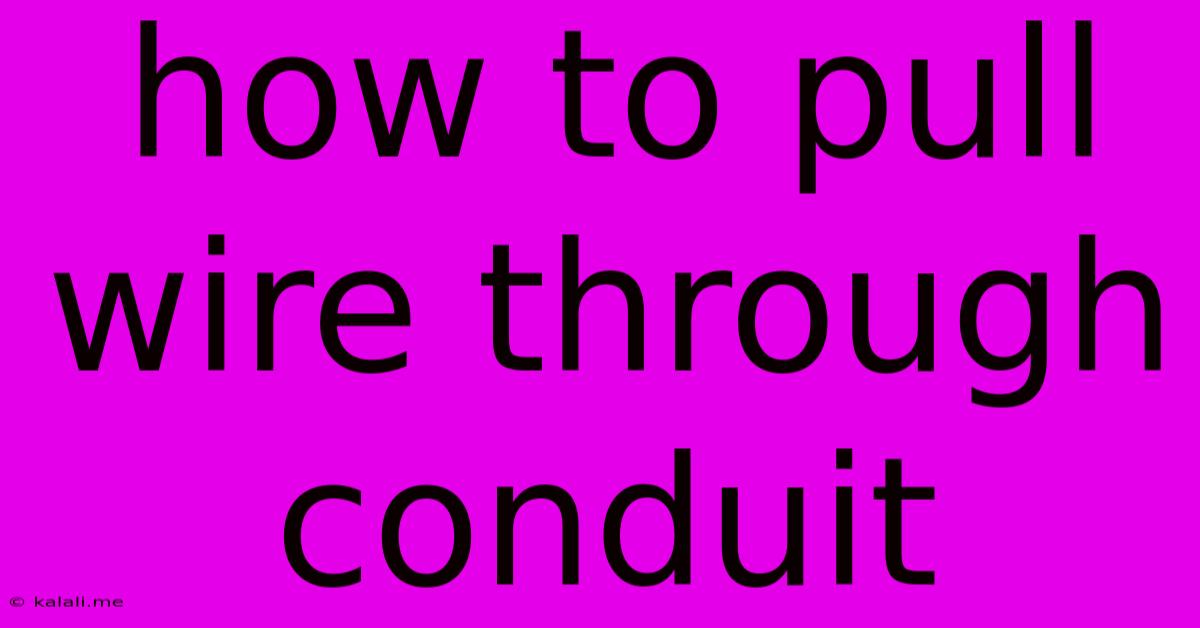How To Pull Wire Through Conduit
Kalali
Jun 03, 2025 · 4 min read

Table of Contents
How to Pull Wire Through Conduit: A Comprehensive Guide
Pulling wire through conduit can seem daunting, but with the right tools and techniques, it's a manageable task for DIYers and experienced electricians alike. This guide covers everything from preparation to troubleshooting, ensuring a smooth and efficient process. Whether you're working on a small residential project or a larger commercial installation, understanding these steps is crucial for a successful outcome.
Preparing for the Pull: Essential Tools and Safety Precautions
Before you begin, gather the necessary tools and prioritize safety. This will significantly reduce the frustration and risk involved.
Essential Tools:
- Fish Tape: This flexible metal tape is the workhorse for navigating conduit bends and obstructions. Different sizes are available; choose one appropriate for your conduit size.
- Wire Pulling Lubricant: This is crucial for reducing friction and making the pulling process significantly easier. There are various types available, including powdered lubricants and gels.
- Conduit Bender (optional): For correcting minor bends or creating slight adjustments to the conduit route.
- Gloves: Protect your hands from cuts and abrasions.
- Safety Glasses: Essential for eye protection from debris or stray wires.
- Flashlight: Useful for inspecting conduit runs, especially in dark or confined spaces.
- Measuring Tape: To accurately measure wire lengths and conduit runs.
- Wire Pulling Grip: For a secure grip on the wire during the pulling process.
- Cable Reel (for larger projects): To manage and dispense long lengths of wire.
Safety Precautions:
- Always disconnect power: Before working with any electrical wiring, ensure the power is completely disconnected at the breaker box.
- Wear appropriate safety gear: This includes gloves, safety glasses, and potentially other protective equipment depending on the work environment.
- Be aware of potential hazards: Watch out for sharp edges, obstructions within the conduit, and other potential dangers.
- Take breaks: Pulling wire can be physically demanding; take breaks to avoid fatigue and injury.
The Pulling Process: Step-by-Step Instructions
Now that you're prepared, let's tackle the actual wire pulling process:
-
Access Points: Ensure you have clear access to both ends of the conduit run.
-
Lubrication: Generously apply wire pulling lubricant to the wire's outer sheath. This is essential for smooth pulling, especially in longer runs or conduits with bends.
-
Feeding the Fish Tape: Insert the fish tape into the conduit from one access point, carefully guiding it through bends using gentle pressure. Feel for obstructions. If you encounter resistance, try using a smaller fish tape or a different approach.
-
Attaching the Wire: Securely attach the wire to the fish tape. This can be achieved using various methods, including specialized wire grips or even simple tape (ensure it's strong enough).
-
Pulling the Wire: Slowly and steadily pull the wire through the conduit. Avoid jerking or applying excessive force, as this could damage the wire or the conduit. If you meet significant resistance, investigate the cause before continuing.
-
Inspecting the Wire: Once the wire is completely through, inspect it for any damage. If damage is discovered, the process should be repeated with a new wire.
-
Repeat: Repeat steps 2-6 for each additional wire required.
Troubleshooting Common Problems
Even with careful planning, you might encounter difficulties. Here are some common problems and solutions:
- Obstructions in the Conduit: Try using a smaller fish tape or a different pulling technique. A small diameter snake or plumbing auger can also be helpful in certain situations.
- Kinks or Tight Bends: Consider using a conduit bender to slightly adjust the conduit's curvature, or try using a different lubricant.
- Excessive Friction: Ensure sufficient lubrication is used and consider using a more effective lubricant type.
- Difficult-to-Reach Areas: Employ specialized tools, such as a longer fish tape or a different access point.
Tips for Success
- Proper planning is key: Carefully map out the conduit run before you begin.
- Use the right tools: Invest in quality tools that are appropriate for the job.
- Be patient and persistent: Pulling wire can be time-consuming; don't rush the process.
- Seek professional help if needed: If you encounter significant challenges or are unsure about any aspect of the process, it's always best to seek the assistance of a qualified electrician.
Pulling wire through conduit is a skill that improves with practice. By following these steps and utilizing the troubleshooting advice, you’ll be able to navigate this essential electrical task with confidence. Remember, safety is paramount; always prioritize safe working practices and seek professional help when necessary.
Latest Posts
Latest Posts
-
What Is The Best Gfci Breaker
Jun 05, 2025
-
How To Get Rid Of Villagers Acnh
Jun 05, 2025
-
Why Do Olympic Swimmers Wear Two Caps
Jun 05, 2025
-
What Is The Plural Of Series
Jun 05, 2025
-
Why Do We Associate Certain Objects With Authority
Jun 05, 2025
Related Post
Thank you for visiting our website which covers about How To Pull Wire Through Conduit . We hope the information provided has been useful to you. Feel free to contact us if you have any questions or need further assistance. See you next time and don't miss to bookmark.